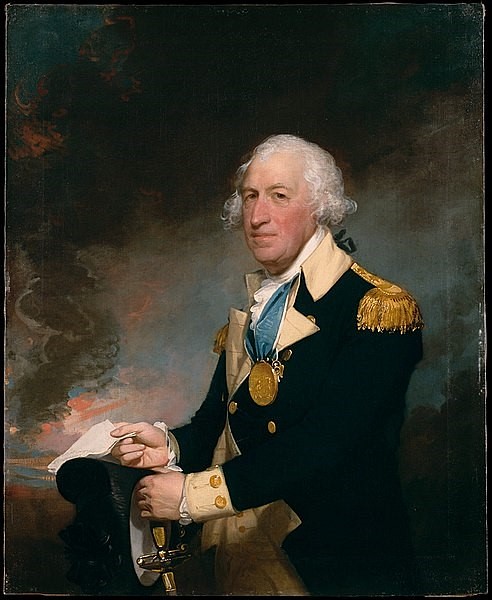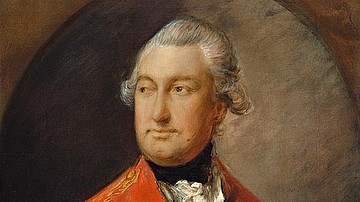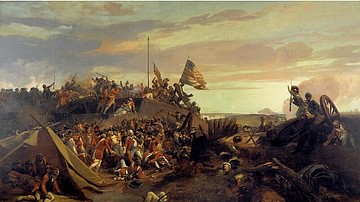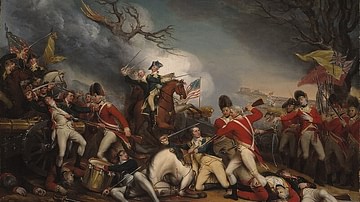The Battle of Camden (16 August 1780) was a major battle of the southern theater of the American Revolutionary War (1775-1783). It saw a British army under Lord Charles Cornwallis decisively defeat an American force under General Horatio Gates, thereby securing British control of South Carolina and allowing Cornwallis to invade North Carolina.
Background: Fall of Charleston
On 29 March 1780, over 12,000 British and German soldiers under the command of Sir Henry Clinton dug in outside the landward walls of Charleston, South Carolina, and began to lay siege. Over the course of the next six weeks, the British siegeworks crept closer to the city walls, as the ubiquitous roar of artillery echoed in the sky. Charleston was, at the time, the largest and most important city in the American South. Its capture would provide the British with a base from which to launch an invasion of the South, one of the most economically significant regions of the United States. The exports of southern cash crops such as indigo, rice, and tobacco were used to fund the American war effort; should the South fall back under British control, the US would lose access to this major source of revenue and would be less capable of military upkeep. The amputation of the South from the body of the United States would, it was believed, be the fatal blow to the young republic.
This was a fact that Major General Benjamin Lincoln, commander of the Southern Department of the Continental Army, knew all too well. As the British completed their entrapment of his army in Charleston, Lincoln knew that time was running out for both his army and the South, and he could only hope that help was on its way. General George Washington, commander-in-chief of the American forces, was unable to come to Lincoln's aid himself, as he was currently in New Jersey with the main army keeping an eye on the sizable British force in New York City. However, Washington was able to spare two regiments of Continentals (or regular soldiers), sending them south under the capable command of Major General Johann de Kalb. Simultaneously, the 380 troops of the 3rd Virginia Regiment under Colonel Abraham Buford crossed into South Carolina, intent on coming to Charleston's defense.
But before either of these detachments could arrive to reinforce the city, Lincoln's hand was forced. By early May, Clinton's siegeworks had approached the city walls, allowing the British to unleash an artillery barrage that engulfed the wooden buildings of Charleston in flames. Unwilling to subject his army and the city's residents to further carnage, Lincoln surrendered on 12 May; at least 2,500 Continentals were taken prisoner (the British reported over 5,000 prisoners), and Charleston was occupied by the British. Clinton then set about pacifying the state of South Carolina, offering pardons to any Patriot militiamen willing to change sides and fight for the British; as a result, the British were able to recruit nearly 4,000 men for their Loyalist militias over the summer.
Clinton also dispatched Lt. Colonel Banastre Tarleton, and his infamous unit of elite Loyalists known as the British Legion, in pursuit of Colonel Buford's Virginians. On 29 May, Tarleton attacked Buford at the Battle of Waxhaws on the border between North and South Carolina. The battle quickly devolved into a bloodbath, as Tarleton's troops allegedly massacred the Continental soldiers while they were trying to surrender; this led the Patriots to coin the phrase ‘Tarleton's Quarter' to refer to the brutality of British officers. With the elimination of Buford's regiment, the last remnants of the American southern army had been destroyed, leaving the South open to British subjugation.
Satisfied with this outcome, Clinton returned to New York City in early June, leaving his second-in-command, Lord Charles Cornwallis, in charge of finishing the pacification of South Carolina. This was easier said than done, as the brutality of Waxhaws inspired hundreds of men to join Patriot militias that were sprouting up across the South Carolina backcountry. Men like Thomas Sumter, Francis Marion, and Andrew Pickens led small bands of partisan fighters on attacks against British and Loyalist troops, frustrating Cornwallis' attempts to solidify his authority in the region. As the weeks wore on and Cornwallis' grip on South Carolina began to slip, the Patriots spotted a chance to regain control of the state. But to do so, they would have to rebuild their southern army fast.
Gates' Grand Army
There was already a foundation upon which the Patriots could build this new army. General de Kalb had made it to the Deep River, 30 miles (48 km) south of Greensboro, North Carolina, when he received news of Charleston's fall. Rather than make a futile attempt to invade what was now enemy territory, Kalb decided to stay put as he awaited fresh orders. Born in Bavaria to a peasant family, Johann de Kalb cut an intimidating figure; standing over six feet (182 cm) tall in an age when men were much shorter, he was broad-shouldered and muscular. He was a seasoned veteran of several European wars, having served in the French army under the famous Maurice de Saxe (l. 1696-1750). A mentor to Marquis de Lafayette, Kalb had arrived in America in July 1777 to join the Continental Army and had been given command of a division at Valley Forge. Now, sitting in his North Carolina camp, he had his first independent command and was eager to prove himself in battle.
But the Bavarian's command would not remain independent for long. On 25 July 1780, General Horatio Gates arrived, announcing that Congress had instructed him to take command of Kalb's 1,400 Continentals and form them into a new southern army. General Gates was still revered by many Americans for his victory at the Battles of Saratoga (autumn 1777), in which he had forced the surrender of an entire British army. Gates was regarded as a man of action, a foil to the overly cautious Washington; Gates had, in fact, been associated with the Conway Cabal, a failed attempt to remove Washington from command of the army. Though his participation in the so-called ‘cabal' had cost him some prestige, his military track record remained impressive enough for Congress to place the hope of the South in him. Significantly, Washington was not consulted about Gates' appointment, since Gates' friends in Congress had known that the commander-in-chief would not have approved.
Gates was eager to prove that he was still the hero of Saratoga and, on 27 July, ordered his scrappy army to take the direct road to Camden, South Carolina, to begin the reconquest of that state. His officers advised him against such a direct approach, which would take the army through a landscape of swamps and war-ravaged farmland that was populated mainly by hostile Loyalists. Colonel Otho Williams, Gates' adjutant, even offered a less dangerous alternative route to the west. Gates refused to listen, believing that the direct approach was best, and immediately marched his troops down the long road to Camden. Just as Williams and the other officers had warned, the countryside was dishearteningly desolate, having been picked clean of food and supplies by the warring militias; the army remained dangerously low on food the entire march.
On 7 August, morale was slightly raised when Gates' force was joined by 2,100 North Carolina militia under General Richard Caswell. On 14 August, the army reached Rugeley's Mill, about 12 miles (19 km) from Camden, where it was reinforced by 700 Virginia militia under General Edward Stevens. Gates had, by this point, begun to refer to his force as his 'Grand Army' and believed he commanded more than 7,000 men. When the level-headed Colonel Williams corrected him that the army numbered only 3,052 effectives, Gates expressed surprise but was ultimately unconcerned, stating that "there are enough [soldiers] for our purposes" (Boatner, 163).
Preparations
On 9 August, Lord Cornwallis learned that Gates was headed for Camden. The town had been converted into a supply depot for the British army and was garrisoned by around 1,000 soldiers under the young Lord Francis Rawdon. Cornwallis decided to meet the American threat head-on and arrived at Camden himself on 13 August, boosting the number of British troops in the town to around 2,200. These men consisted of experienced regular soldiers as well as units of seasoned Loyalists from New York who had been battling the Patriots for years. Also accompanying Cornwallis was Lt. Colonel Tarleton and his British Legion, whose blood-soaked reputation had spread far and wide in the months since Waxhaws. Cornwallis believed that he was outnumbered – like Gates himself, Cornwallis severely overestimated the size of the American army. Nevertheless, Cornwallis decided to fight; a retreat from Camden would jeopardize British control of South Carolina and could possibly spell an end to the all-important southern campaign.
Meanwhile, on 15 August, General Gates announced his intention to assault the British position at Camden the following morning. Once again, his officers were skeptical of his orders, since many of the soldiers had been weakened by hunger during the march from North Carolina. Gates, however, made it clear that he was not looking for contrary opinions, and at 10 p.m. that night, the so-called 'Grand Army' set out on the road to Camden. Coincidentally, Cornwallis had also made the decision to attack; the British had also left Camden around 10 p.m. and were now marching along the same road, coming from the opposite direction. The two armies collided at around 2:30 in the morning on 16 August. Beneath a dark and moonless sky, Tarleton's dragoons rode straight into the American vanguard. Both sides were surprised to see one another, and after a brief and confusing skirmish, the British and the Americans both withdrew, neither side wanting to fight a disorientating night battle.
It seems that this unexpected encounter left Gates somewhat shaken. As dawn approached, he called a war council in which he uncharacteristically asked his officers' advice about what to do next. Annoyed that Gates had not heeded their earlier advice, most of the officers remained passive-aggressively silent. The silence was finally broken by the militia general Edward Stevens, who asked his fellow officers: "Gentlemen, is it not too late now to do anything but fight?" (Boatner, 165)
The Battle
At daybreak, the two armies discovered that they were separated by only 250 yards (228 m) of open field. The battlefield was constrained on either side by dense swamps. The Americans were situated on slightly higher ground, having gotten into position in the predawn gloom. Gates deployed his army in a way that was customary in 18th-century warfare, positioning his strongest units (regiments of Continentals from Delaware and Maryland) on his right flank and putting his weakest troops (the North Carolina and Virginia militias) on his left flank. Unfortunately for Gates, Cornwallis had had the exact same idea. The strongest units in Cornwallis' army – the well-seasoned 23rd and 33rd Regiments of Foot – were positioned on the British right flank, opposite the American militia. Cornwallis' less experienced units, including the Volunteers of Ireland and his newly raised Loyalist troops, were positioned on his left flank, opposite Gates' Continentals. Cornwallis kept Tarleton's dragoons in reserve, ready to chase down the Americans once they began to flee.
Instances of light skirmishing took place as the armies were getting into position, but it was only after sunrise that the battle truly began. Each army's artillery began shelling the enemy position, and soon the field was covered in a blanket of hazy smoke. Around this time, Colonel Otho Williams was informed by an artillery officer that the British had not finished deploying; they were still in the process of transitioning from column to line formation. Williams became excited, believing that the British were still vulnerable to attack, and suggested to General Gates that they strike first. Gates agreed and, not wishing to waste any time, decided to send forth the Virginian militia since they were already in formation. Gates gave the order to attack – the first and last command he would issue that day. General Stevens, leading the Virginia militia, had them fix bayonets before charging into the murky field. It was not long until Stevens' Virginians ran headlong into the British regulars who were also in the process of attacking. The sight of the British soldiers, who were "firing and huzzaing" as they advanced, struck terror into the militiamen, many of whom threw down their weapons and fled without having fired a shot (Middlekauff, 462).
The North Carolina militia had watched their Virginian comrades advance into the smoky field; now, they witnessed those same Virginians running back, closely pursued by the scarlet-coated British. The North Carolinians, who like the Virginians were inexperienced and undisciplined, likewise panicked, tossing their muskets aside and running from the field. The fighting had barely begun, and the entire American left wing had already collapsed. The fate of the American army now rested in the Continental soldiers on the right wing, under the overall command of the Bavarian General Johann de Kalb. Up until this point, Kalb's Continentals had held their ground, repulsing two assaults made by the British left flank under Lord Rawdon. Kalb had counterattacked, and for a moment, it was all Rawdon could do to keep his troops from breaking. But the collapse of the American left wing had sealed Kalb's fate, as the British troops were now able to circle around and strike Kalb's exposed flank.
Otho Williams realized what was happening and tried to send in the reserve troops, the 1st Maryland Brigade, to Kalb's aid. However, the Marylanders were unable to make it very far before the fleeing militiamen, blinded by their panic, ran straight into them, throwing the Maryland Brigade into disorder. This delay proved fatal for Kalb's Continentals, who soon found themselves outflanked. Kalb did his best to rally his troops but was thrown to the ground when his horse was killed from under him. The resilient Bavarian struggled to his feet, continuing to shout orders in his booming voice. He had been wounded several times and was bleeding heavily from a saber gash to the head. Before long, his strength gave out, and he collapsed; the wounds proved to be mortal, and he died three days later.
With the fall of Kalb, the Continentals were very near to breaking, and Cornwallis decided to unleash Tarleton to finish the job. Tarleton led his dragoons around to strike the Continental rear, breaking up their formation and sending them running. While some Americans rallied and held their ground for a little while longer, the Battle of Camden was largely over by noon. Gates, having watched his army disintegrate before his eyes, leapt on a horse and rode from the battlefield. He did not stop until he had reached the safety of Charlotte, North Carolina, some 60 miles (96 km) away. From there, he continued on to Hillsboro, claiming that he had wanted to secure a base there to reform his army. There was, however, no army to reform; Gates' 'Grand Army' had been annihilated in a single battle, the second American army to be destroyed in the span of only three months.
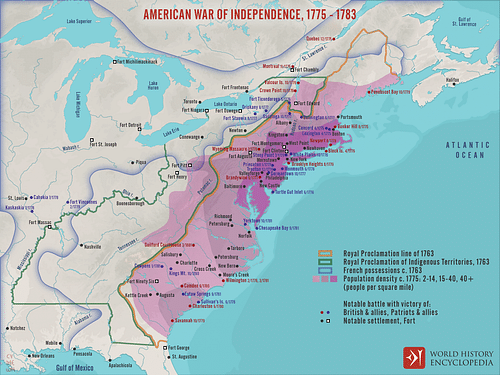
Aftermath
Coming so soon after the defeats at Savannah, Charleston, and Waxhaws, Camden was a devastating blow to the Patriot cause. An estimated 900 Americans were killed or wounded in the chaos, with another 1,000 taken prisoner; the British, by contrast, had lost only 68 killed and 238 wounded. It was one of the most complete British victories of the war, solidifying Britain's subjugation of South Carolina; after the fall of Georgia the previous year, it was the second state to fall back under royal authority. With only the pesky Patriot militias standing in his way, Cornwallis was now free to consider an invasion of North Carolina, bringing the British one step closer to completing their conquest of the South. The fledgling United States had never seemed closer to annihilation.
The Patriots, after getting over the initial shock of the defeat, wasted little time building a third southern army. This time, Gates would not be entrusted with the command. His defeat at Camden and his inglorious flight to Hillsboro had lost him the confidence of Congress; once revered as the 'Hero of Saratoga', Gates would never again hold a significant field command. This time, Congress decided to authorize General Washington to choose Gates' replacement. The commander-in-chief selected his most trusted subordinate, General Nathanael Greene, who took command of a reconstituted southern army in October 1780. Greene's style of command was similar to Washington's own, and he conducted the southern campaign with the same kind of cautious, Fabian strategy that Washington had been utilizing in the north to great effect. This paid off, as Greene had more or less freed the Carolinas from British control by the time that the Siege of Yorktown (28 September to 19 October 1781) brought most of the fighting to an end.



